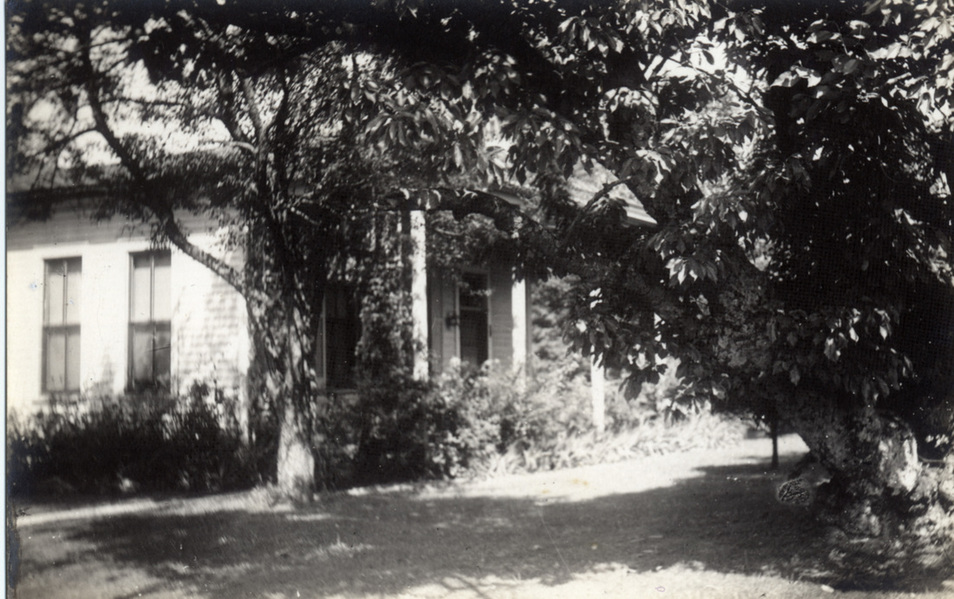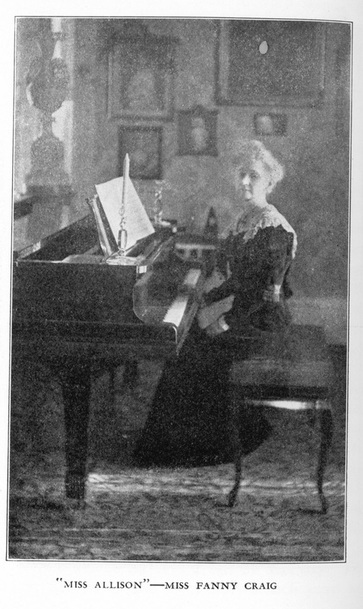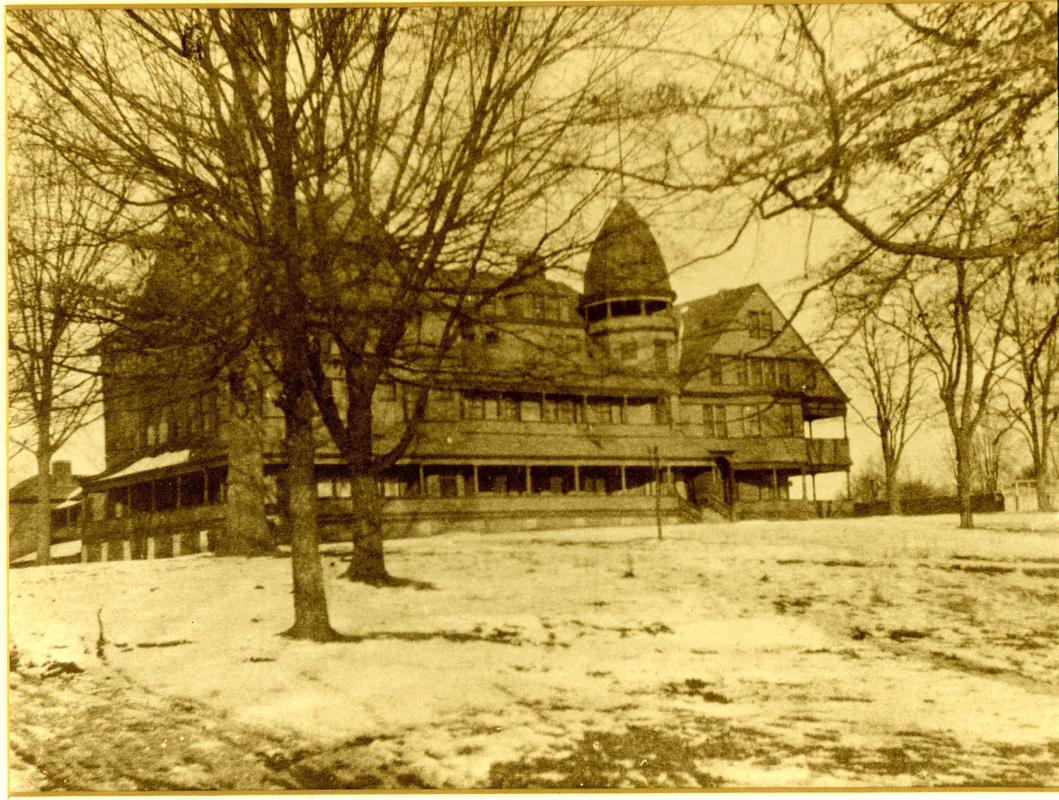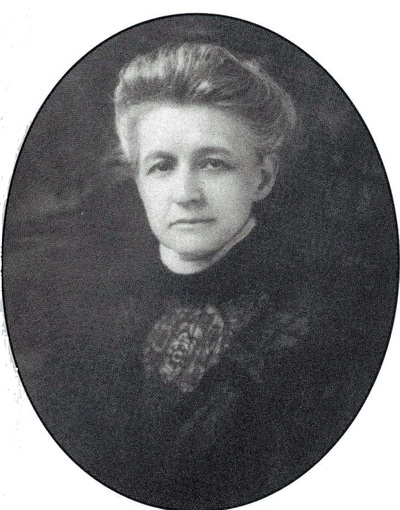Villa Ridge School

The last Villa Ridge School building was on the Edgewood estate, Fanny Craig's home on Central Avenue. Kate Matthews photo postcard from The Filson Historical Society, Louisville, Kentucky. The post card was captioned, “Miss Allison McIntyre’s School house, where the ‘Little Colonel’ attended. The old cherry tree where she learned her lessons.” Fanny Craig was Annie Fellows Johnston's inspiration for "Miss Allison McIntyre" in the Little Colonel stories.
|
by an intervening space. When the children were called to recite they came to this area. Halfway between Miss Fanny’s desk and the children there was a large wood-1877 Kentucky College for Young Ladies graduate Fanny Craig filled the void left in Pewee Valley's local primary and secondary private education when the college burned in 1900 by starting the Villa Ridge School. The school was first held on the ground floor of the former Villa Ridge Inn until the building was purchased in 1902 for use as the Kentucky Confederate Home.
Then it moved to a one-story, clapboard schoolhouse behind Edgewood, her home on Central Avenue. Fanny served as headmistress, and the school was generally known as Miss Fanny Craig’s School. The article below, written by Florence Dickerson for a special bicentennial issue of the Call of the Pewee, describes what attending the Villa Ridge School was like: The entrance hall where the boys and girls hung their coats and hats led to a large school room where Miss Craig taught the younger children. Also opening from one side of the entrance hall was a smaller classroom in which the Reverend Mr. Creighton, the Pewee Valley Presbyterian Church minister, taught older children. Miss Fanny’s desk was located at one end of the large room and was separated from the children’s desks by an intervening space. |
|
 Fanny Craig taught the community's African-American children how to read and write on Sundays. The children shown in this photo probably belonged to Sylvia Gaines. Photo by Kate Matthews. From the Fox Film Scrapbook, Oldham County Historical Society.
Fanny Craig taught the community's African-American children how to read and write on Sundays. The children shown in this photo probably belonged to Sylvia Gaines. Photo by Kate Matthews. From the Fox Film Scrapbook, Oldham County Historical Society.
When the children were called to recite they came to this area. Halfway between Miss Fanny’s desk and the children there was a large wood-burning stove which heated the room.
Two smaller rooms opened from the large class room. One room contained Miss Fanny’s piano; the other had locked storage cabinets.
Memorabilia collected by a Presbyterian missionary during her travels had been given to V.R.S. and it was stored in these locked cabinets. Included in these items were cocoa and coffee beans. One day several children surreptitiously obtained the key to the cabinets and ate all the cocoa and coffee beans. (Editor's note: the missionary was probably Louise Cleland, wife of the late Rev. T.H. Cleland and a former teacher at the Kentucky College for Young Ladies.)
Two smaller rooms opened from the large class room. One room contained Miss Fanny’s piano; the other had locked storage cabinets.
Memorabilia collected by a Presbyterian missionary during her travels had been given to V.R.S. and it was stored in these locked cabinets. Included in these items were cocoa and coffee beans. One day several children surreptitiously obtained the key to the cabinets and ate all the cocoa and coffee beans. (Editor's note: the missionary was probably Louise Cleland, wife of the late Rev. T.H. Cleland and a former teacher at the Kentucky College for Young Ladies.)
 Fanny Craig playing the piano in the window bay of Edgewood's long drawing room. Photo by Kate Matthews. From "Land of the Little Colonel: Reminiscences and Autobiography" by Annie Fellows Johnston, 1929.
Fanny Craig playing the piano in the window bay of Edgewood's long drawing room. Photo by Kate Matthews. From "Land of the Little Colonel: Reminiscences and Autobiography" by Annie Fellows Johnston, 1929.
Mr. Creighton was succeeded by Dr. Peyton Hoge, also a Presbyterian minister, who taught Latin. The Misses Henderson and Yowenstein were teachers at Villa Ridge School sometime during its existence.
The basic skills of reading, writing, arithmetic and grammar were taught and the textbooks of Noble Butler, a respected grammarian and well known resident of Pewee Valley, were used. Miss Fanny’s students all remember how much she read both poetry and prose to them and how they enjoyed it. In the winter they would sit around the stove and listen as she made the characters from the classics become real and in warmer weather they went outdoors to enjoy the stories. Since Miss Craig was an accomplished musician, singing as well as costumed dramatic presentations were a part of the curriculum.
One of the students recalls that to practice addition Miss Fanny would write long columns of figures on the blackboard and they would race to see who could add them the quickest. Jim Erwin, who became a banker, was usually the first to get to the correct answer.
The Villa Ridge School pin, a Victorian design three-quarters of an inch long and a half inch wide, had gold letters and a gold outline on a divided green and white background. (Note: The Filson Historical Society has a Villa Ridge School pin in their collection.)
The children brought their lunches and they would trade one another for the choice of goodies. One of the girls remembers that Amelia Moody usually had ham and beaten biscuit which were in great demand. In very cold weather Miss Fanny would make hot chocolate for lunch.
Weather permitting, the children played in the yard at recess, there were swings and see-saws and girls as well as boys played football. They must have had a good foundation in the sport because two of the boys became captains of their college teams: Woodford Dulaney at Yale and Clem Johnston at Centre.
Always charmed by Miss Fanny’s elegant clothes, her pupils remember especially a blue velvet gown with a train inherited from her affluent sister (editor's note: Louise Craig Culbertson) along with many other velvet and silk and lace dresses. To be able to teach school in such clothes was indeed an accomplishment.
Being a fine musician, Miss Fanny also gave piano lessons. When Amelia Moody, one of her piano students, entered The New England Conservatory of Music her admission tests were so advanced they doubted she had graduated only from a high school, The Kentucky Home School. She explained that her extensive musical knowledge had been acquired from her piano teacher, Miss Craig.
…Miss Alice Ross, Mr. Herbert Ross and Mr. and Mrs. Harbourt, all of whom still live in Pewee Valley, attended Villa Ridge School.”
The basic skills of reading, writing, arithmetic and grammar were taught and the textbooks of Noble Butler, a respected grammarian and well known resident of Pewee Valley, were used. Miss Fanny’s students all remember how much she read both poetry and prose to them and how they enjoyed it. In the winter they would sit around the stove and listen as she made the characters from the classics become real and in warmer weather they went outdoors to enjoy the stories. Since Miss Craig was an accomplished musician, singing as well as costumed dramatic presentations were a part of the curriculum.
One of the students recalls that to practice addition Miss Fanny would write long columns of figures on the blackboard and they would race to see who could add them the quickest. Jim Erwin, who became a banker, was usually the first to get to the correct answer.
The Villa Ridge School pin, a Victorian design three-quarters of an inch long and a half inch wide, had gold letters and a gold outline on a divided green and white background. (Note: The Filson Historical Society has a Villa Ridge School pin in their collection.)
The children brought their lunches and they would trade one another for the choice of goodies. One of the girls remembers that Amelia Moody usually had ham and beaten biscuit which were in great demand. In very cold weather Miss Fanny would make hot chocolate for lunch.
Weather permitting, the children played in the yard at recess, there were swings and see-saws and girls as well as boys played football. They must have had a good foundation in the sport because two of the boys became captains of their college teams: Woodford Dulaney at Yale and Clem Johnston at Centre.
Always charmed by Miss Fanny’s elegant clothes, her pupils remember especially a blue velvet gown with a train inherited from her affluent sister (editor's note: Louise Craig Culbertson) along with many other velvet and silk and lace dresses. To be able to teach school in such clothes was indeed an accomplishment.
Being a fine musician, Miss Fanny also gave piano lessons. When Amelia Moody, one of her piano students, entered The New England Conservatory of Music her admission tests were so advanced they doubted she had graduated only from a high school, The Kentucky Home School. She explained that her extensive musical knowledge had been acquired from her piano teacher, Miss Craig.
…Miss Alice Ross, Mr. Herbert Ross and Mr. and Mrs. Harbourt, all of whom still live in Pewee Valley, attended Villa Ridge School.”
In her memoir, "Sunshine and Shadow," privately published in 1983 by Rev. Peyton Hoge's daughter, Carrie Hoge Meade described her experiences at the Villa Ridge School on pgs. 51-53:
"Miss Fannie Craig, and her mother and brothers, lived next door to us. She played the organ at church, and she also ran a little school in a small building on their place, with the help of one assistant. There was a big room where we had our desks in one end, and Miss Fanny taught in the other end and a smaller room where her assistant, sometimes Miss Annie and sometimes Miss French Blackley, taught. Then there was a little room for our coats and rubbers, and that was it. There was a big stove in the big room and a smaller stove in Miss Blackley's room, but no plumbing or electricity. There was plenty of light from the windows, and nothing went on there at night, so lights were not needed. (As a matter of fact, our houses in Pewee Valley were all lighted with lamps until several years later.)
There were perhaps 25 pupils in this school, ranging in age from first grade through high school. Naturally the curriculum was limited, with so few pupils and only two teachers, so grades were somewhat mixed up. But Miss Fannie managed wonderfully, and she taught us far more than could be found in books.
She also gave me piano lessons, and I think back to her patience and kindness with deep gratitude all these many, many years. I didn't read music well, because I kept looking at my hands and so lost the place. Miss Fanny said that my hands were like bad children who didn't do what they should unless being watched. I tried hard to keep my eyes on the music, and she tried many tricks to keep me from looking at those unruly hands, but I never did learn to sight read. Mama taught me French, and later Papa taught me Latin. When, after struggling through grammar and Caesar's Gallic wars, we started Virgil, he made me and the others who joined the class feel the majesty and beauty of the lines, and each day he prepared a translation of our lesson in iambic hexameter verse to read to us after we had fumbled and stumbled through the lesson.
"Miss Fannie Craig, and her mother and brothers, lived next door to us. She played the organ at church, and she also ran a little school in a small building on their place, with the help of one assistant. There was a big room where we had our desks in one end, and Miss Fanny taught in the other end and a smaller room where her assistant, sometimes Miss Annie and sometimes Miss French Blackley, taught. Then there was a little room for our coats and rubbers, and that was it. There was a big stove in the big room and a smaller stove in Miss Blackley's room, but no plumbing or electricity. There was plenty of light from the windows, and nothing went on there at night, so lights were not needed. (As a matter of fact, our houses in Pewee Valley were all lighted with lamps until several years later.)
There were perhaps 25 pupils in this school, ranging in age from first grade through high school. Naturally the curriculum was limited, with so few pupils and only two teachers, so grades were somewhat mixed up. But Miss Fannie managed wonderfully, and she taught us far more than could be found in books.
She also gave me piano lessons, and I think back to her patience and kindness with deep gratitude all these many, many years. I didn't read music well, because I kept looking at my hands and so lost the place. Miss Fanny said that my hands were like bad children who didn't do what they should unless being watched. I tried hard to keep my eyes on the music, and she tried many tricks to keep me from looking at those unruly hands, but I never did learn to sight read. Mama taught me French, and later Papa taught me Latin. When, after struggling through grammar and Caesar's Gallic wars, we started Virgil, he made me and the others who joined the class feel the majesty and beauty of the lines, and each day he prepared a translation of our lesson in iambic hexameter verse to read to us after we had fumbled and stumbled through the lesson.
An Evening Program from Villa Ridge College After its Move to the Villa Ridge Hotel
The Villa Ridge School Behind Edgewood Shortly Before Demolition

Villa Ridge schoolhouse ca. 1981, six years before it was demolished for the Edgewood subdivision. After Fanny Craig closed the school, the building was rented out as a home. Brent and Irene Million, owners of Millions grocery store, lived here in the 1920s. Later, it was lived in by the Heavrin family. From the Kentucky Historic Resources Inventory by Carol Tobe.








